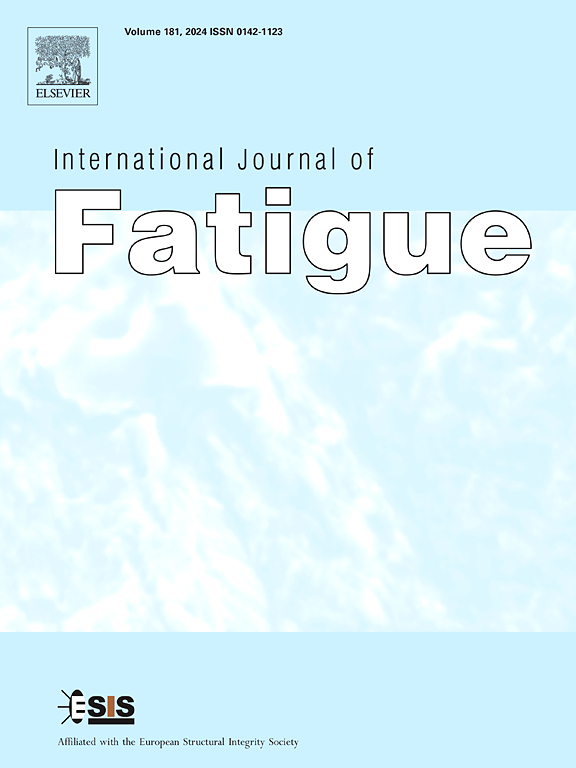Fatigue life evaluation model of friction self-piercing riveted aluminum alloy sheets based on the structural stress method
IF 6.8
2区 材料科学
Q1 ENGINEERING, MECHANICAL
引用次数: 0
Abstract
Friction self-piercing riveting (F-SPR) provides an enabling technology for achieving high-efficiency riveting without prefabricated holes in aerospace. Hence it is of great significance to evaluate the fatigue life of the novel F-SPR joints under different loads. For this purpose, three types of F-SPR joints are designed to account for different fatigue loaded states, including high-load stress state joints, zero-load stress state joints and low-load stress state joints. Fatigue tests with different load levels are conducted to acquire the fatigue life data of F-SPR joints. The typical failure location of the F-SPR joints is determined as the region surrounding the rivet tip in the lower sheet. The structural stress on the critical cross-section of F-SPR joints is analytically derived via structural stress theory. A simplified model with beam-shell element of the F-SPR joint is proposed to calculate the structural stress. The contribution of different structural stress components to the effective structural stress is quantified, and the normal structural stress is identified as the critical factor for all the joints. Finally, the master S-N curve for different joints is fitted, achieving the unified life evaluation for F-SPR joints. Meanwhile, the high correlation of the fitting results proves the validity of the proposed model. The proposed method is useful for the analysis of both F-SPR and other spot-welded structures.
基于结构应力法的摩擦自穿铆接铝合金板疲劳寿命评价模型
摩擦自穿孔铆接(F-SPR)为实现航空航天领域的高效铆接提供了一种无需预制孔的技术。因此,评估新型F-SPR接头在不同载荷下的疲劳寿命具有重要意义。为此,针对不同的疲劳加载状态,设计了三种类型的F-SPR节点,分别为高载应力状态节点、零载应力状态节点和低载应力状态节点。进行了不同载荷水平下的疲劳试验,获得了F-SPR接头的疲劳寿命数据。F-SPR接头的典型失效位置确定为下部板材中铆钉尖端周围的区域。利用结构应力理论解析推导了F-SPR节点临界截面上的结构应力。提出了一种简化的F-SPR节点梁-壳单元计算结构应力的模型。量化了不同结构应力分量对有效结构应力的贡献,确定了法向结构应力是所有节点的关键因素。最后,拟合了不同节点的主S-N曲线,实现了F-SPR节点的统一寿命评估。同时,拟合结果的高相关性证明了所提模型的有效性。该方法适用于F-SPR和其他点焊结构的分析。
本文章由计算机程序翻译,如有差异,请以英文原文为准。
求助全文
约1分钟内获得全文
求助全文
来源期刊

International Journal of Fatigue
工程技术-材料科学:综合
CiteScore
10.70
自引率
21.70%
发文量
619
审稿时长
58 days
期刊介绍:
Typical subjects discussed in International Journal of Fatigue address:
Novel fatigue testing and characterization methods (new kinds of fatigue tests, critical evaluation of existing methods, in situ measurement of fatigue degradation, non-contact field measurements)
Multiaxial fatigue and complex loading effects of materials and structures, exploring state-of-the-art concepts in degradation under cyclic loading
Fatigue in the very high cycle regime, including failure mode transitions from surface to subsurface, effects of surface treatment, processing, and loading conditions
Modeling (including degradation processes and related driving forces, multiscale/multi-resolution methods, computational hierarchical and concurrent methods for coupled component and material responses, novel methods for notch root analysis, fracture mechanics, damage mechanics, crack growth kinetics, life prediction and durability, and prediction of stochastic fatigue behavior reflecting microstructure and service conditions)
Models for early stages of fatigue crack formation and growth that explicitly consider microstructure and relevant materials science aspects
Understanding the influence or manufacturing and processing route on fatigue degradation, and embedding this understanding in more predictive schemes for mitigation and design against fatigue
Prognosis and damage state awareness (including sensors, monitoring, methodology, interactive control, accelerated methods, data interpretation)
Applications of technologies associated with fatigue and their implications for structural integrity and reliability. This includes issues related to design, operation and maintenance, i.e., life cycle engineering
Smart materials and structures that can sense and mitigate fatigue degradation
Fatigue of devices and structures at small scales, including effects of process route and surfaces/interfaces.
 求助内容:
求助内容: 应助结果提醒方式:
应助结果提醒方式:


